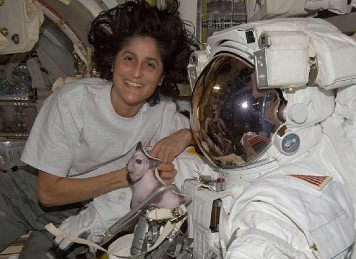Sunita Williams may embark on third space mission on May 17

The first-ever crewed launch of Boeing’s Starliner capsule delayed due to a “buzzing” valve on its rocket ride
Indian American astronaut Sunita Williams is now expected to embark on her third mission into space on May 17 with the first-ever crewed launch of Boeing’s Starliner capsule delayed due to a “buzzing” valve on its rocket ride.
NASA astronauts Williams and Butch Wilmore were strapped onto their seats in the spacecraft at Cape Canaveral’s Space Launch Complex-41 in Florida and preparing for liftoff atop a United Launch Alliance (ULA) Atlas V rocket on May 6 when the mission known as Crew Flight Test (CFT) was “scrubbed.”
READ: Glitch delays Sunita Williams’ third space mission (May 7, 2024)
The launch team called the attempt off about two hours before the planned liftoff after noticing that an oxygen relief valve in the Atlas V’s Centaur upper stage was “buzzing” — opening and closing very rapidly.
ULA, Boeing and NASA initially pushed CFT’s liftoff back to no earlier than Friday (May 10), but that’s no longer the plan. ULA has decided to replace the valve, which will require rolling the Starliner-Atlas V stack off the launch pad and back to an assembly building.
As as result, CFT’s launch is now targeted for no earlier than May 17, NASA announced in an update on Tuesday (May 7). A May 17 launch, should it go forward, would occur at 6:16 p.m. EDT (2216 GMT).
Williams and Wilmore will remain in crew quarters at NASA Kennedy in quarantine until the next launch opportunity. The duo will be the first to launch aboard Starliner to the International Space Station (ISS) for a roughly eight-day stay as part of the agency’s Commercial Crew Program.
READ: Sunita Williams set for first piloted launch of Boeing’s Starliner (April 26, 2024)
The CFT is a shakeout cruise designed to show that Starliner is ready to fly operational, six-month crewed missions to the orbiting lab.
After Williams and Wilmore disembarked from Starliner on Monday evening and headed back to their crew quarters at nearby Kennedy Space Center, ULA teams began testing and analyzing the troublesome valve.
Technicians “successfully commanded the valve closed, and the oscillations were temporarily dampened,” NASA officials wrote in Tuesday’s update.
“The oscillations then re-occurred twice during fuel removal operations,” they added. “After evaluating the valve history, data signatures from the launch attempt, and assessing the risks relative to continued use, the ULA team determined the valve exceeded its qualification, and mission managers agreed to remove and replace the valve.”
Boeing developed Starliner under a $4.2 billion contract awarded by NASA’s Commercial Crew Program in 2014. SpaceX got a similar deal worth $2.6 billion at the same time for work on its Dragon capsule.
READ: Sunita Williams to fly Starliner’s first crewed mission to Space Station (June 17, 2022)
SpaceX flew its version of CFT, a two-astronaut test flight called Demo-2, back in 2020. The company has completed seven long-term astronaut missions to the ISS for NASA and is in the middle of its eighth, which is known, appropriately enough, as Crew-8.
Williams was selected as an astronaut by NASA in 1998 and has been aboard the International Space Station twice. She was set to return to the space station for a third time, traveling aboard Boeing’s Starliner spacecraft as a pilot.
She has previously undertaken two space missions, Expeditions 14/15 and 32/33. During Expedition 14/15 (December 2006 – June 2007), Williams established a world record for female astronauts by conducting four spacewalks totaling 29 hours and 17 minutes outside the ISS.
In Expedition 32/33 (July – November 2012), she served as flight engineer and ISS commander, conducting three spacewalks alongside Akihiko Hoshide of the Japan Aerospace Exploration Agency (JAXA).
Williams has accrued 322 days in space across her missions, with a cumulative spacewalk time of 50 hours and 40 minutes, once a record for female astronauts.

